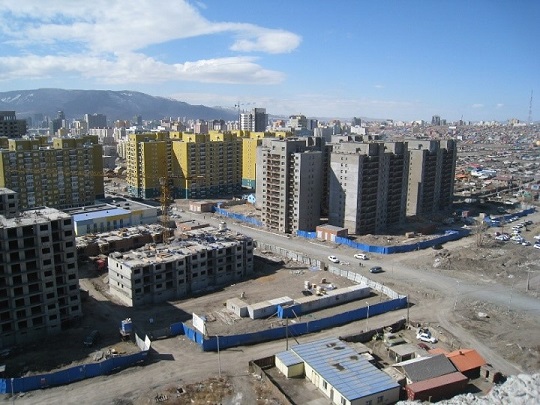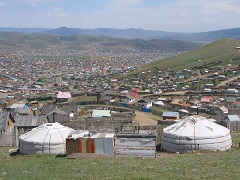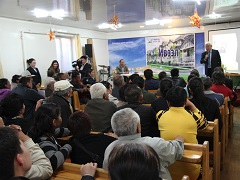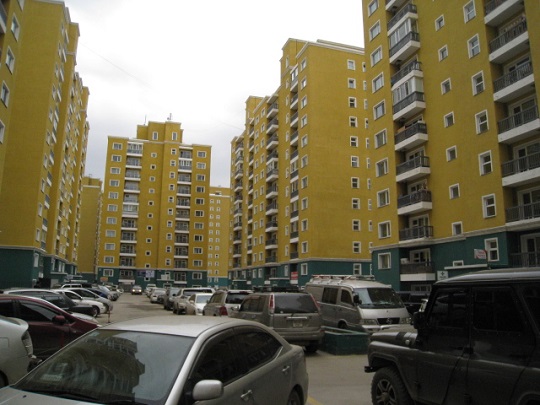- Home
- News & Features
- News
- FY2019
- Ulaanbaatar, a reborn city: 10 years of urban development in a rapidly expanding city
News
October 16, 2019
Ulaanbaatar, a reborn city: 10 years of urban development in a rapidly expanding city
Ulaanbaatar, the capital of Mongolia, has undergone rapid and chaotic urbanization due to a mass influx of nomads who have been unable to manage their pastures due to the wave of economic liberalization, as well as the severe snow damage that occurs once every few years. As problems such as environmental pollution and the expansion of inadequate infrastructure areas becoming more serious, the Mongolian government seeks support from Japan, which is a “third neighbor country.” We look back on JICA's 10-year commitment to urban development in today’s Ulaanbaatar, as it grows into a modern city.
 The scene of the target area of the “ger-to-apartment projects,” which is one of the redevelopment methods stipulated in the Urban Redevelopment Law. Ger area’s low-rise housing are being transformed into an apartment area with developed infrastructure (Ulaanbaatar District 7, photo taken in 2015)
The scene of the target area of the “ger-to-apartment projects,” which is one of the redevelopment methods stipulated in the Urban Redevelopment Law. Ger area’s low-rise housing are being transformed into an apartment area with developed infrastructure (Ulaanbaatar District 7, photo taken in 2015)
Resident participation in urban development policy
 The ger areas of Ulaanbaatar in June 2006. Since the only available infrastructure for livelihood is electricity, air pollution caused by coal stoves and groundwater pollution caused by 200,000 toilets dug into the ground result in major environmental and social problems
The ger areas of Ulaanbaatar in June 2006. Since the only available infrastructure for livelihood is electricity, air pollution caused by coal stoves and groundwater pollution caused by 200,000 toilets dug into the ground result in major environmental and social problems
The Privatization Law, which was established in Mongolia in 1992 in accordance with the democratic constitution, made it possible for people to freely choose the location of residence. In Mongolia, livestock is considered an asset. Many of the nomads who lost their livestock due to the snow damage migrated to Ulaanbaatar, where they had relatives and acquaintances. There, they built mobile houses called “gers.” The population of Ulaanbaatar, which was about 650,000 in 1998, increased to about 1.49 million in 2018 (that year the population of Mongolia was about 3.32 million from the Mongolian National Bureau of Statistics homepage). The area around the city, where many gers are built, was labeled the “ger area,” and up to about 60% of the city's population live there.
In order to resolve the urban problems of Ulaanbaatar, JICA implemented three technical cooperation projects from 2007 to 2018. Katsuhide Nagayama, a JICA Expert involved in a series of projects, speaks about urban development as follows:
“As more people flocked to the city, the population grew beyond the capacity of services that the city could provide, and the city was devastated. In other words, the environment of Ulaanbaatar was unable to cope with the population of the city. Urban development was needed for residents to live comfortably.”
Technical cooperation projects for Ulaanbaatar development implemented by JICA

 A town meeting with area landowners and the region’s readjustment project candidate, Bat-Uul, then Mayor of Ulaanbaatar. This was a great opportunity to increase awareness of the redevelopment with the residents (Photo taken in 2015)
A town meeting with area landowners and the region’s readjustment project candidate, Bat-Uul, then Mayor of Ulaanbaatar. This was a great opportunity to increase awareness of the redevelopment with the residents (Photo taken in 2015)
The City Master Plan was created with the participation of residents, so that the draft of the policy should be something close to the “point of view of the citizens.” Since the idea of incorporating the opinions of residents never existed in the country’s previous administrative system, some people shunned the idea of “having an opinion on what the government decides.” However, gradually the concept of ‘public (meaning the entire society)' became widespread. Nagayama said that residents have become aware that they play the main role. The Master Plan, created by the residents as a whole, was approved by the parliament in 2013 after confirmation by the Mongolian Ministry.
In addition, the project also supported legislation related to urban development. The "Urban Redevelopment Law" was enacted in 2015 in order to improve the living environment by promoting the use of apartments in the ger areas. What was necessary for the creation of laws and systems was the discussion of social norms in the country. Nagayama recalls, "We held unrelenting and persistent discussions with the ministry officials in Mongolia."
Also, in the area of infrastructure development, there was a technological exchange with Asahikawa city, Hokkaido, which has a similarly cold climate to Ulaanbaatar. The government, NGOs, and private companies cooperated in supporting the project, including measures against frozen road surfaces, and energy-saving measures such as using high thermal insulation and airtight buildings. In 2011, the two cities signed a memorandum of understanding on cold climate technical cooperation, which included the implementation of several grassroots technical cooperation projects and the acceptance of technical trainees from Ulaanbaatar.
For the improvement of a living environment
The background to the adoption of the Urban Redevelopment Law was the growing number of people flooding into the ger area seeking a “better living environment.” Ger is a traditional dwelling in Mongolia, but the city dwellers in Ulaanbaatar were seeking a more convenient life with water supply, hot water, and heating, rather than their previous lives of carrying heavy coal and water daily. In addition, when we questioned residents about their “ideal city,” many of them answered a “healthy and safe city.”
Ulaanbaatar is currently working on projects to improve the ger areas and studying the development of new housing policies for low-income people, and they continue to seek JICA's technical assistance to solve these issues.
 A new apartment built by ger-to-apartment project. Residents are pleased that life has become more convenient through connecting to water and sewage, hot water, and heating (UB District 7, September 2016)
A new apartment built by ger-to-apartment project. Residents are pleased that life has become more convenient through connecting to water and sewage, hot water, and heating (UB District 7, September 2016)
“The model they envision for ‘Ulaanbaatar in 2030’ is the city of Sapporo. There is a friendly relationship between the two cities because of their common cold weather, and Sapporo is often introduced in Mongolian TV programs. While Sapporo is still developing as a modern city, it is spacious and resembles Ulaanbaatar. When we look at the landscape of Sapporo, we often say, ’It would be nice to see Ulaanbaatar develop like this’,” says Nagayama, who has maintained ties with Ulaanbaatar for a long time.
- About JICA
- News & Features
- Countries & Regions
- Our Work
- Thematic Issues
- Types of Assistance
- Partnerships with Other Development Partners
- Climate Change / Environmental and Social Considerations
- Evaluations
- Compliance and Anti-corruption
- Science and Technology Cooperation on Global Issues
- Research
- JICA Development Studies Program / JICA Chair
- Support for the Acceptance of Foreign HRs / Multicultural and Inclusive Community
- Publications
- Investor Relations





